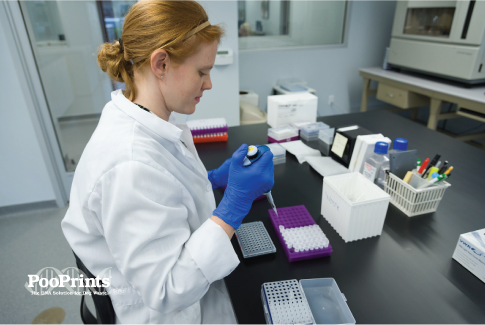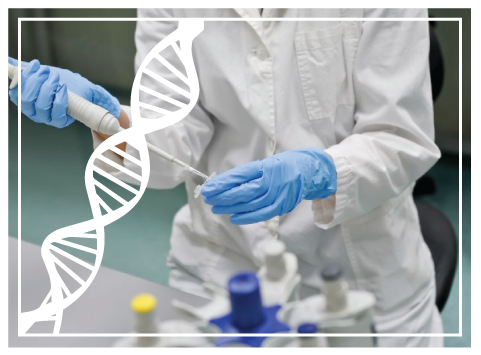The Science Behind The Science
“Cells in the body contain the same nuclear DNA. The exceptions to this being the male and female gametes as well as mature red blood cells. When we extract DNA from feces, we are extracting DNA from cells. These cells are readily shed during excretion as the feces moves through the intestines. Therefore, in the most basic of comparisons, DNA from cells from the intestines should be identical to DNA extracted buccal cells, skin cells, tissue, and hair follicle cells.
Cross contamination of a fecal sample is possible in highly used green spaces. In these rare cases, we will detect at least 2 genotypes within one sample. Alleles amplify in different ways; some have lower intensity than others. Therefore, we make no attempt to decipher what DNA profile is at a higher concentration and the major contributor. We will not discern what allele belongs to what dog, and will therefore fail the sample as contaminated. We receive thousands of waste samples each year and this occurrence is extremely rare.
For our purpose, urine is not a reliable source for nuclear DNA. Urine from healthy animals should not contain enough cells to produce a strong genetic profile using our standard fecal and buccal extraction protocols. Certain sample sources, like urine and saliva, require more concentration of the eluate to produce quality template DNA for amplification.”
Chesleigh Winfree
Senior Scientist


Our Lab
PooPrints research and development team continues to explore genetic science in a
state-of-the-art laboratory capable of creating canine DNA profiles and DNA matching.
BioPet Laboratories conforms to all international standards under the ISO 17025: 2017 for testing
laboratories.
Do you want to learn more about our laboratory or our company? Check out our parent company’s
site, BioPet Laboratories.


Sample Analysis
To begin PooPrints analysis, we extract genomic DNA from buccal swabs to establish each community’s reference database. Microsatellite (STR) fragment analysis is used to establish genotypes of 15 loci (each with 2 possible alleles) plus a gender marker to give us increased specificity with many data points. In reference, the FBI core panel for its CODIS database consisted of 13 loci plus a gender marker from October 1998 until December 31, 2016 (7). Our 15 loci, each with hundreds of allele combinations, give us the high probability of producing a unique genetic ‘fingerprint’ from many sample types – buccal swab, feces, tissue, semen, etc. Extraction methods vary according to the sample type in order to overcome specific inhibitors (i.e. bacteria and enzymes in feces). Fecal samples require mechanical and chemical cell lysis as well as many wash steps to retrieve the DNA located in the nucleated cells collected in the sample. Once genomic DNA is extracted, all samples are plated for PCR and analyzed using capillary electrophoresis.
Our Standards
BioPet Laboratories is committed to uphold industry standards, customer standards, and protect the environment with minimal chemical waste. Our DNA World Pet Registry has customized the most precise data analysis coupled with allelic frequency statistics in unique algorithms. Our laboratory demonstrates technical competency to perform molecular testing for genetic profiling of biological samples as outlined by the specification in ISO 17025:2017 international standards. BioPet exhibits compliance across sampling, sample handling and protection, testing, test reporting, record maintenance, validation of analytical methods, controlled environment, traceability, equipment calibration testing and maintenance, and qualification of personnel as outlined in BioPet Laboratories Quality and Procedures Manual.
All instruments including electronic pipettes, analytical balances, reagent cold storage, etc. must pass maintenance, yearly calibration, and certification from an ISO/IEC 17025:2017 accredited outside provider. Considered the industry gold standard in medium to high throughput in genetic analysis, our Applied Biosystems 3730 DNA Analyzer uses capillary electrophoresis and is also certified yearly by an AB service engineer. Our laboratory analyst must complete training and evaluation in each category before moving on to analyze our customer samples. These standards allow BioPet Laboratories to offer precise and reproducible DNA fragment analysis.

Data Comparison
Waste Samples (TD numbers) and DN profiles are generated independently and without bias. DNA isolation, PCR, and capillary fragment analysis are conducted as per internally validated methods. A genotype yielded from a waste sample is simply compared to all buccal swab genotypes from that property. For a Match to be resulted, the genotypes MUST completely match on every available allele with no discrepancy. For this reason, a false positive match is extremely unlikely.
For every Match, there is a probability based on the profile frequency within the population. This will determine the likelihood that another matching genotype exists in addition to the reported match. The Random Match Probability can be thought of as the probability that another dog in addition to the match identified may display the same genetic profile. This should not be confused with the idea that another dog matches instead of the reported match. Profile statistics are calculated from a population of over 10,000 dogs with unique genetic profiles. This allows us to accurately predict the allele frequency, genotype frequency, and thus profile frequency.
DNA matches must be indistinguishable and contain enough comparative loci to show distinction in a population. This distinction is built into our matching software in terms of our minimum data cutoff. Based on our database and the frequency of the alleles present in a given DNA profile, the probability of another genotype matching in addition to the reported dog having the same combination of alleles, range from 1 in 1 million to greater than 1 in 60 sextillion. This means we can be confident that the generated profile is truly a unique identifier.
All of our tests are carried out in our lab.
PooPrints is proud to have an in-house lab at the BioPet Laboratories facility that is staffed with lead scientists in the animal genetics industry. The process of DNA collection involves extracting DNA from swabbing the inside of a dog’s cheek, collecting buccal cells. The DNA information is then securely and privately stored in the World Pet Registration DNA database.
